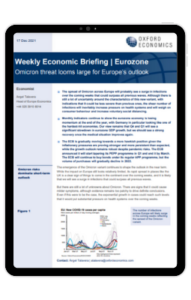Omicron threat looms large for Europe’s outlook

The spread of Omicron across Europe will probably see a surge in infections over the coming weeks that could surpass all previous waves. Although there is still a lot of uncertainty around the characteristics of this new variant, with indications that it could be less severe than previous ones, the sheer number of infections will inevitably increase pressure on health systems and will weigh on consumer behaviour and increase voluntary social distancing.
What you will learn:
- Monthly indicators continue to show the eurozone economy is losing momentum at the end of the year, with Germany in particular looking like one of the hardest-hit economies.
- Our view remains that Q4 and Q1 will see a significant slowdown in eurozone GDP growth, but we should see a strong recovery once the medical situation improves again.
- The ECB is gradually moving towards a more hawkish position given the inflationary pressures are proving stronger and more persistent than expected, while the growth outlook remains robust despite pandemic risks.
Tags:
Related research

Post
Forecasting Economic Outcomes from the US Election
As the US election approaches, the potential economic outcomes are on everyone’s mind. Regardless of the result, the economy is poised for significant changes driven by the policy decisions of the next president and Congress.
Find Out More
Post
Japan’s BoJ is now likely to front-load policy normalisation
We now expect the Bank of Japan will implement an additional rate hike this year, possibly in October, given the hawkish forward guidance at the July meeting. We previously projected the central bank would wait until next spring to hike again. Thereafter, we expect the BoJ to become more cautious and raise rates only once per year in 2025 and 2026 to reach a terminal rate of 1%.
Find Out More